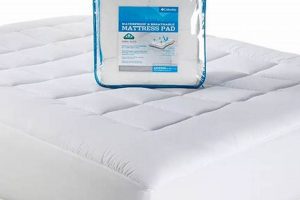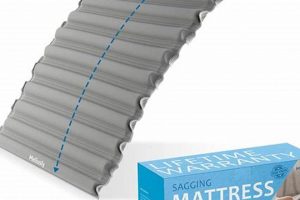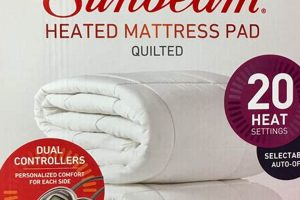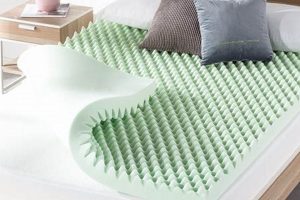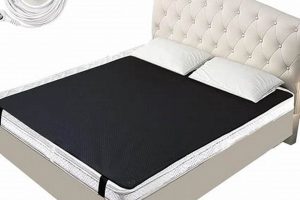A bedding layer crafted from naturally derived materials, placed atop a mattress, serves to enhance comfort and protection. These products often incorporate substances such as organic cotton, wool, latex, or bamboo. The composition prioritizes elements sourced directly from the environment, minimizing or eliminating synthetic components found in conventional counterparts.
The significance of choosing such an item lies in its potential health and environmental advantages. Reduced exposure to volatile organic compounds (VOCs) is a primary benefit, as these materials typically undergo less chemical processing. Furthermore, these items can offer improved breathability and temperature regulation, leading to more restful sleep. Historically, the use of unprocessed fibers in bedding reflects a return to simpler, healthier lifestyles and a growing awareness of ecological responsibility.
The subsequent sections will delve into specific material types utilized in production, outline relevant certifications and standards, address considerations for cleaning and maintenance, and compare the characteristics and benefits associated with different material choices.
Selecting and Maintaining Bedding Layers
The following guidance offers considerations for choosing and preserving a bedding layer made from natural materials to ensure both longevity and optimal performance.
Tip 1: Material Selection: Prioritize materials certified by reputable organizations, such as GOTS (Global Organic Textile Standard) or Oeko-Tex, to verify the absence of harmful substances and the integrity of the sourcing and production processes. For example, consider a wool product with a GOTS certification.
Tip 2: Thickness and Construction: Evaluate the thickness and construction based on individual needs. A thicker layer may offer more cushioning, while a thinner design might be preferable for maintaining mattress firmness. Quilted construction can help to prevent clumping and maintain even distribution of the fill.
Tip 3: Breathability Assessment: Opt for breathable materials like cotton, wool, or bamboo, which facilitate airflow and minimize moisture accumulation. This feature is particularly beneficial for individuals prone to overheating during sleep.
Tip 4: Allergy Considerations: Be mindful of potential allergens. While wool is naturally hypoallergenic for some, individuals with lanolin sensitivities should explore alternative options such as cotton or latex.
Tip 5: Regular Cleaning Practices: Adhere to the manufacturer’s care instructions for cleaning. Spot cleaning is recommended for minor stains, while some can be machine washed on a delicate cycle. Avoid harsh detergents and bleach, as these can damage the natural fibers.
Tip 6: Drying Protocols: When machine drying is permitted, use a low heat setting. Air drying is often preferable to prevent shrinkage or fiber damage. Ensure the layer is completely dry before placing it back on the mattress to prevent mold growth.
Tip 7: Protective Measures: Consider using a mattress protector underneath the bedding layer to further shield the mattress from spills and stains. This extra layer can extend the lifespan of both the mattress and the topper.
Adherence to these suggestions contributes to a more comfortable, hygienic, and sustainable sleep environment, maximizing the benefits associated with natural materials.
The concluding section will summarize the key advantages and address future trends in this area.
1. Material Composition
The selection of constituent materials is paramount in defining the characteristics and benefits associated with a bedding layer marketed as a “natural mattress pad.” The composition directly influences factors such as comfort, durability, environmental impact, and suitability for individuals with sensitivities.
- Fiber Sourcing
The origin and processing of fibers dictate the overall “natural” designation. Materials such as organic cotton, certified by entities like GOTS, ensure that cultivation avoids synthetic pesticides and fertilizers. Wool, if sourced from ethically raised sheep and processed with minimal chemicals, can also contribute to a more natural composition. Conversely, conventionally grown cotton or wool treated with harsh chemicals may detract from the intended benefits.
- Fill Material
The fill material, which provides cushioning and support, often consists of latex, wool batting, or down alternatives derived from plant-based sources. Natural latex, harvested from rubber trees, offers resilience and breathability. Wool batting provides temperature regulation and moisture-wicking properties. Down alternatives, if made from materials like bamboo fibers, can mimic the softness of down while being hypoallergenic and sustainable. The choice of fill significantly impacts the overall comfort and performance of the pad.
- Chemical Treatments
The absence or minimization of chemical treatments is a crucial aspect. Conventional mattress pads may undergo processes involving flame retardants, stain repellents, or antimicrobial agents. Natural alternatives prioritize materials that inherently possess these properties or employ non-toxic treatments. For example, wool is naturally flame-resistant. The reduction of chemical exposure contributes to a healthier sleep environment and reduces potential environmental harm.
- Construction Techniques
The methods used to assemble the materials also play a role. Hand-tufting, quilting with natural thread, and the avoidance of synthetic adhesives contribute to a more “natural” construction. These techniques minimize the use of synthetic components and enhance the overall durability and longevity of the pad.
In summary, the material composition is a defining characteristic of a natural mattress pad. It dictates the product’s health benefits, environmental impact, and overall performance. Careful consideration of fiber sourcing, fill material, chemical treatments, and construction techniques is essential for selecting a bedding layer that aligns with individual needs and sustainability values.
2. Breathability Factors
The inherent nature of a “natural mattress pad” significantly influences breathability, which is the capacity to facilitate air circulation and moisture regulation. Materials employed in its construction, such as organic cotton, wool, and natural latex, possess intrinsic properties that promote airflow. These materials, unlike many synthetics, allow for the dissipation of heat and moisture vapor produced during sleep, mitigating the risk of overheating and promoting a more comfortable rest. For instance, wool fibers have a complex structure that wicks away moisture, maintaining a dry and temperate sleep surface. In contrast, a co
nventional mattress pad made with synthetic materials like polyester can trap heat and moisture, leading to discomfort and potential disruption of sleep.
The breathability of a natural mattress pad directly affects sleep quality and overall health. Improved air circulation reduces the accumulation of allergens and dust mites, creating a healthier sleep environment, particularly beneficial for individuals with allergies or asthma. Additionally, the enhanced moisture regulation minimizes the growth of mold and bacteria, contributing to improved hygiene. The structure of open-cell latex, for example, allows for superior airflow compared to closed-cell foam, further enhancing breathability and reducing heat retention. This feature is especially important in warmer climates or for individuals who tend to sleep hot.
In summation, breathability stands as a critical factor intertwined with the use of natural materials in a mattress pad. It enhances sleep quality through temperature regulation, moisture management, and allergen reduction. Challenges in achieving optimal breathability may arise from blending natural and synthetic materials, emphasizing the importance of verifying material composition. Comprehending the role of breathability connects to the broader theme of sustainable and healthy sleep environments, underscoring the value of selecting bedding products that prioritize natural, breathable components.
3. Hypoallergenic Properties
The presence of hypoallergenic properties in a mattress pad constructed from natural materials is a significant consideration for individuals susceptible to allergies and sensitivities. The composition and processing of these materials directly influence the prevalence of allergens and irritants, potentially contributing to a more comfortable and healthier sleep environment.
- Material Composition and Allergenicity
The inherent allergenicity of constituent materials dictates the pad’s overall suitability for sensitive individuals. Organic cotton, for instance, is typically grown without synthetic pesticides and fertilizers, minimizing potential irritants. Wool, while naturally hypoallergenic for some due to its lanolin content, can be problematic for others. Natural latex possesses hypoallergenic properties, but sensitivities can occur. Careful consideration of individual allergies is crucial when selecting a pad with natural components.
- Dust Mite Resistance
Natural mattress pads often exhibit enhanced resistance to dust mite colonization compared to synthetic alternatives. Materials such as wool and latex possess inherent properties that inhibit dust mite proliferation. Wool’s natural moisture-wicking capabilities create an unfavorable environment for these allergens, while latex’s density and structure provide fewer harborages. This resistance contributes to a reduction in allergy symptoms, such as sneezing and congestion, for sensitive individuals.
- Absence of Synthetic Chemicals
The absence or minimization of synthetic chemicals in natural mattress pads reduces the potential for allergic reactions. Conventional pads may contain flame retardants, dyes, and other chemicals that can trigger sensitivities. Natural alternatives prioritize materials that inherently possess desirable properties or utilize non-toxic treatments. This reduction in chemical exposure minimizes the risk of respiratory and skin irritations.
- Processing and Purification Methods
The methods employed to process and purify natural materials significantly impact their hypoallergenic properties. Thorough washing and cleaning processes remove residual allergens and impurities from fibers such as cotton and wool. Certification standards, such as GOTS, ensure that materials are processed with minimal chemical inputs. These purification methods contribute to a reduction in potential allergens and irritants.
In summary, the hypoallergenic properties of a natural mattress pad are intrinsically linked to the composition, construction, and processing of its constituent materials. Careful selection of materials with low allergenicity, inherent dust mite resistance, and minimal chemical treatments is essential for creating a sleep environment that minimizes the risk of allergic reactions and promotes restful sleep for sensitive individuals. Comparing various natural pads to identify those that best meet specific allergenic needs is a crucial step in the selection process.
4. Maintenance Requirements
The longevity and hygienic integrity of a natural mattress pad are directly influenced by adherence to appropriate maintenance protocols. Deviations from recommended care can compromise the material’s integrity and diminish its intended benefits.
- Washing Procedures and Frequency
The frequency and methods employed for washing a natural mattress pad are critical. Over-washing can degrade natural fibers, while infrequent cleaning allows for the accumulation of allergens and dust mites. The use of gentle, pH-neutral detergents is recommended to prevent damage to the materials. For example, washing a wool pad too often with harsh chemicals can strip its natural lanolin, diminishing its moisture-wicking properties. The manufacturer’s instructions should be followed to determine the appropriate washing frequency and temperature settings.
- Spot Cleaning Techniques
Prompt and appropriate spot cleaning is essential for addressing spills and stains. Utilizing a mild, diluted cleaning solution and blotting the affected area gently can prevent permanent discoloration or damage. Aggressive scrubbing or the use of harsh chemicals can compromise the fibers. For instance, a stain on an organic cotton pad should be treated with a mixture of water and mild soap, avoiding bleach or harsh stain removers.
- Drying Methods and Precautions
Proper drying techniques are crucial to prevent shrinkage, mildew growth, and fiber damage. Air drying is often preferable to machine drying, particularly for delicate materials like wool or latex. If machine drying is necessary, low heat settings should be used. Ensuring the pad is completely dry before placing it back on the mattress prevents the development of mold and bacteria. Direct sunlight can also degrade certain natural fibers, so it should be avoided.
- Storage Considerations
When not in use, proper storage is necessary to maintain the integrity of the mattress pad. Storing it in a clean, dry environment protects it from moisture, dust, and pests. Avoid storing it in airtight containers, as this can trap moisture and lead to mildew growth. Rolling the pad loosely, rather than folding it tightly, prevents creasing and fiber damage. Additionally, storing it away from direct sunlight and extreme temperatures helps to preserve its properties.
Adherence to these maintenance requirements directly influences the lifespan and performance of a natural mattress pad. Neglecting these guidelines can lead to premature degradation, diminishing the benefits derived from the natural materials. Understanding and implementing these procedures ensures a hygienic and comfortable sleep environment.
5. Longevity Expectations
The lifespan of a bedding layer marketed as a “natural mattress pad” is influenced by the selection of materials, manufacturing processes, and adherence to maintenance guidelines. These factors collectively determine the product’s durability and resistance to degradation over time. Selecting a pad constructed from durable materials, such as organic cotton, wool, or natural latex, establishes a foundation for extended use. Manufacturing techniques that prioritize robust construction, such as reinforced stitching and durable quilting patterns, further contribute to its resilience. For instance, a pad made with densely packed wool batting and secured with durable stitching is more likely to withstand compression and maintain its loft over a prolonged period compared to a pad with loosely packed fill and minimal reinforcement.
Proper maintenance practices, encompassing regular cleaning and appropriate storage, are crucial for realizing the full longevity potential. Washing the pad according to the manufacturer’s instructions prevents premature degradation of the natural fibers. Promptly addressing stains and spills prevents permanent damage. Storing the pad in a dry, well-ventilated environment when not in use minimizes the risk of mold and mildew growth. Comparing two similar pads, one meticulously maintained and the other neglected, illustrates the practical impact of maintenance. The well-maintained pad is likely to retain its comfort and support characteristics for a considerably longer duration. Factors can affect longevity for example; If a mattress pad of natural materials is kept in a spare room and only used several times a year it will last longer than on a bed with nightly use. Also quality of the materials can affect longevity. A low quality wool pad will not last as long as a higher quality more dense wool pad.
The anticipated lifespan of a natural mattress pad is directly proportional to the initial investment in quality materials and the consistent application of proper maintenance. These actions are critical for guaranteeing product durability and realizing the full advantages. Neglecting these will likely result in a shorter life span and increase the need to replace the “natural mattress pad”. Choosing pads made with high standards and care will increase longevity and bring better value.
Frequently Asked Questions
The subsequent section addresses common inquiries regarding bedding layers crafted from natural materials. The objective is to clarify uncertainties and provide accurate information to aid in informed decision-making.
Question 1: What constitutes a legitimately “natural” mattress pad?
A product genuinely merits the designation “natural” when its primary components are sourced from nature and minimally processed. Examples include organic cotton, natural latex, and wool. Certification from recognized organizations, such as GOTS or Oeko-Tex, verifies the absence of harmful substances and adherence to environmental standards.
Question 2: How does a mattress pad of this type benefit sleep quality?
The benefits stem from enhanced breathability and temperature regulation. Natural materials facilitate air circulation and moisture wicking, preventing overheating and promoting a more comfortable sleep environment. Reduced exposure to volatile organic compounds (VOCs) is an additional advantage.
Question 3: Are these pads suitable for individuals with allergies?
The suitability depends on the specific materials. Organic cotton and natural latex are generally well-tolerated. However, wool can trigger reactions in individuals with lanolin sensitivities. Careful consideration of individual allergies is essential.
Question 4: What is the typical lifespan of a mattress pad crafted from natural materials?
The lifespan is contingent on material quality, construction, and maintenance. Properly maintained pads can last for several years. Regular cleaning, protection from stains, and appropriate storage contribute to longevity.
Question 5: How does the cost compare to conventional alternatives?
Typically, natural options have a higher initial cost due to the sourcing and processing of materials. However, the potential health and environmental benefits, coupled with extended durability, can offset this difference over time.
Question 6: Can a “natural mattress pad” be washed?
Washing instructions vary depending on the materials used in the pad. Some can be machine washed on a gentle cycle with mild detergent, while others require spot cleaning or professional cleaning to preserve their integrity and longevity.
In summary, this section serves to clarify common questions about natural mattress pads and it gives insights that helps consumers make informed decisions. The advantages are in the selection of materials to the life span of the product.
The final section will present a conclusion. This section highlights the advantages, future trends, and overall value proposition.
Conclusion
The preceding exploration has illuminated the multifaceted nature of the natural mattress pad. From material composition and breathability factors to hypoallergenic properties, maintenance requirements, and longevity expectations, a comprehensive understanding is crucial for informed decision-making. The inherent benefits of selecting products composed of minimally processed, naturally derived materials extend beyond mere comfort, encompassing potential advantages for both individual health and environmental sustainability. Proper selection and care maximize the value proposition, ensuring a worthwhile investment.
The ongoing consumer trend toward sustainable and health-conscious lifestyles suggests a continued increase in demand for bedding options that align with these values. Future advancements in material science and manufacturing processes may further enhance the performance and accessibility of natural mattress pads. Consequently, remaining informed and proactive in researching available options represents a sound approach to optimizing sleep quality and minimizing environmental impact.


